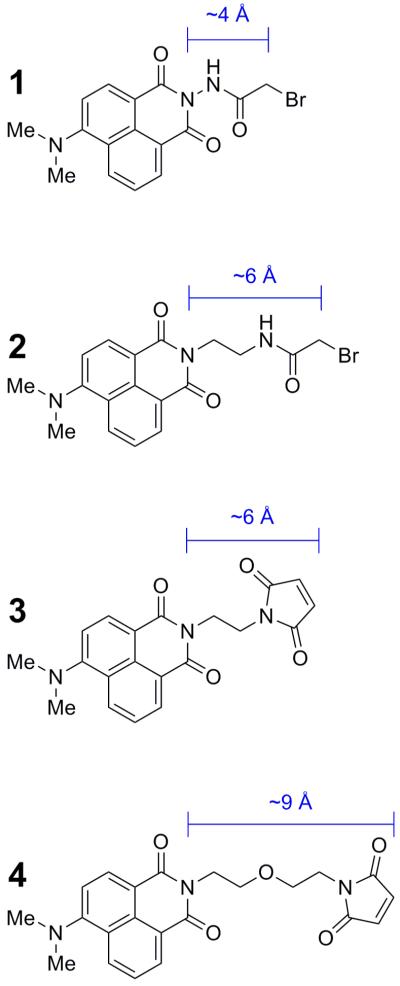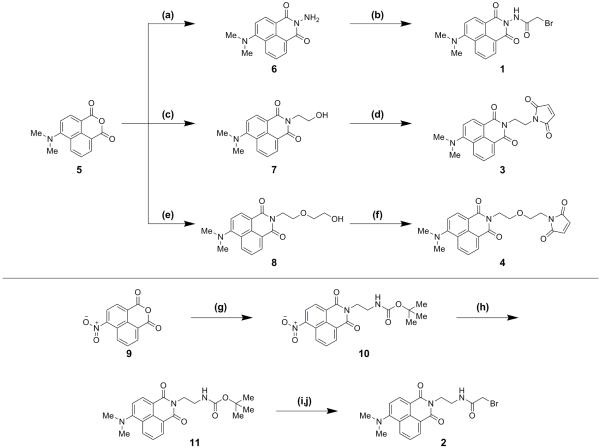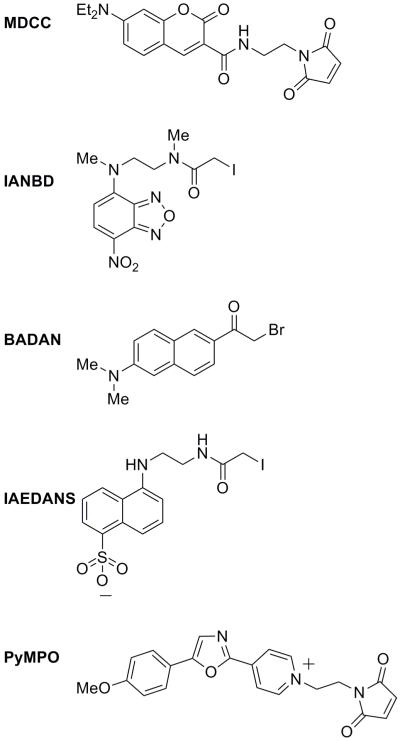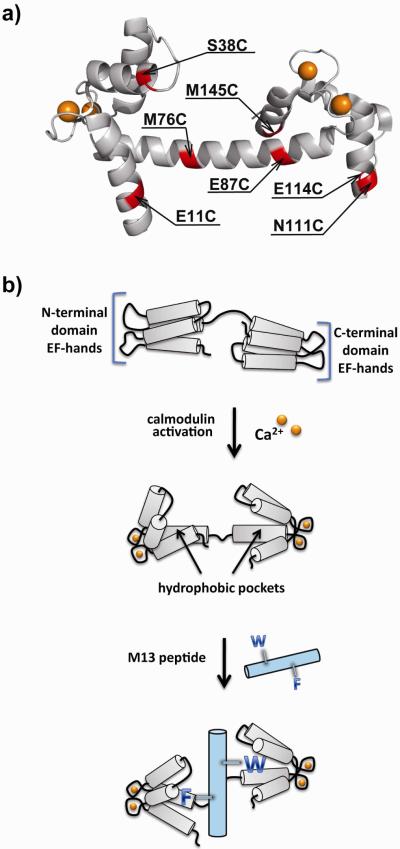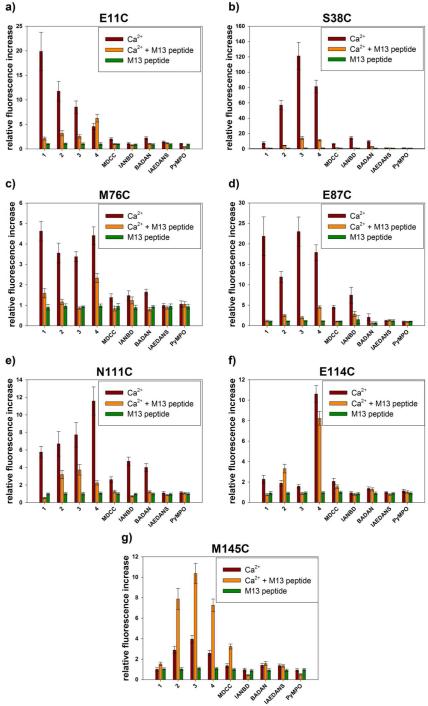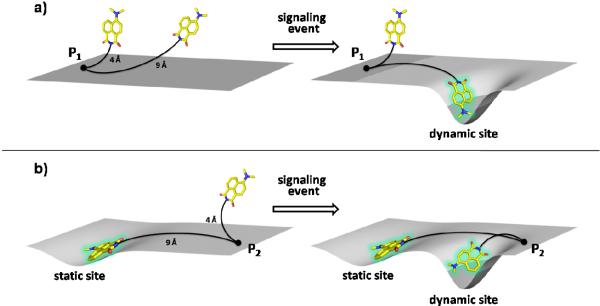Abstract
The solvatochromic fluorophore 4-N,N-dimethylamino-1,8-naphthalimide (4-DMN) possesses extremely sensitive emission properties due largely to the low intrinsic fluorescence it exhibits in polar protic solvents like water. This makes it well suited as a probe for the detection of a wide range of biomolecular interactions. Herein we report the development and evaluation of a new series of thiol-reactive agents derived from this fluorophore. The members of this series vary according to linker type and the electrophilic group required for the labeling of proteins and other biologically relevant molecules. Using the calcium-binding protein calmodulin as a model system, we compare the performance of the 4-DMN derivatives to that of several commercially available solvatochromic fluorophores identifying many key factors import to the successful application of such tools. This study also demonstrates the power of this new series of labeling agents by yielding a fluorescent calmodulin construct capable of producing a greater than 100-fold increase in emission intensity upon binding to calcium.
Introduction
The solvatochromic properties of many environment-sensitive fluorophores have been exploited in a wide range of biological applications such as detecting protein-peptide binding events (1-6), monitoring changes in protein allostery (7-12), and reporting various forms of post-translational modification (13, 14). These fluorophores possess emission properties that are highly sensitive to the nature of the immediate solvent environment. If that environment is altered in a manner that impacts the degree of exposure to water, then such an event could produce a significant change in one or more of the emission properties of the fluorophore (i.e. fluorescence lifetime, emission wavelength, and fluorescence quantum yield) (15). Since both intra- and intermolecular interactions of many proteins often involve a dynamic veiling and unveiling of discrete hydrophobic clefts or pockets within the topology of these macromolecules, an appropriately placed solvatochromic fluorophore can provide a general and facile method of detecting protein function or activation. Due to the adaptable nature of these tools for addressing an array of problems in the biological sciences, many classes of solvatochromic fluorophores are now commercially available in reactive forms ready for direct conjugation to proteins and other relevant biomolecules (16). This diversity offers greater prospects of identifying fluorescent constructs with signaling characteristics suitable for study.
A common application of solvatochromic fluorophores is the development of constructs in which the measured fluorescence change is integrally coupled to a perturbation in a specific aspect of protein structure. Such an approach is particularly advantageous when structural changes are too subtle to be detected by other fluorescence-based methods such as Förster resonance energy transfer (FRET) (17) and fluorescence polarization (FP) (18). However, a practical limitation often encountered when using many of the commercially available solvatochromic probes is that the magnitude of the observed fluorescence change rarely approaches the maximum potential obtained in the context of a typical solvent comparison study (6). The reasons for this observation are varied, but can frequently be attributed in part to the high degree of intrinsic fluorescence exhibited by these fluorophores in water as well as insufficient sensitivity to changes in the local environment.
Herein we report the development of a new series of cysteine modifying agents, 1-4, based on the solvatochromic fluorophore 4-N,N-dimethylamino-1,8-naphthalimide (4-DMN). The principle advantage of this fluorophore, along with other members of the dimethylaminophthalimide family, is that it exhibits extremely low fluorescence quantum yields when exposed to polar protic solvents like water (6). This greatly reduces background signal thereby creating the effect of ‘on-off’ or ‘switch-like’ changes in the observed emission intensity with the potential to exceed ratios of 1000-fold. Furthermore, as previously reported we have determined that this fluorophore possesses significantly greater chemical stability than the other dimethylaminophthalimide dyes we have investigated (6) making it particularly suitable for applications that require prolonged exposure to a wide range of aqueous conditions relevant for most biological applications.
Much of our former work with the dimethylaminophthalimide dyes focused on the development of fluorescent amino acids for incorporation into small peptide-based probes designed to recognize and report binding to discrete protein motifs such as 14-3-3 domains (19), SH2 domains (3), and PDZ domains (20). While these efforts have proved highly successful, our current aim has been to expand the scope of applications to include the integration of these tools into native proteins. However, several fundamental differences must be considered when applying these tools in proteins versus short peptides. With increasing peptide length, the polymer chain exhibits greater potential for adopting higher order structure (21) leading, in some instances, to significant changes in the local environment of the attached fluorophore. Such changes may include the degree of solvent exposure, the frequency of collisional quenching, and the emergence of local electrostatic fields. Additionally, the arrangement of the polymer chain around the dye could restrict certain vibrational modes responsible for non-radiative decay processes that compete with fluorescence. The influence of such structural elements and the effects they impart on the photophysical properties of the fluorophore are difficult to predict and can often complicate efforts toward developing useful fluorescent protein probes that utilize the full potential of the fluorescent tool. Hence, empirical screening approaches are typically required, leading us to focus on the development of a series of cysteine labeling agents. This offers a direct and facile method for the site-selective incorporation of these probes into proteins.
This study identifies key variables that influence the fluorescent response of labeled proteins to changes in protein structure providing a general framework for understanding the ways in which solvatochromic tools may best be applied. Additionally, it reveals a systematic approach to developing future fluorescent protein probes for detecting various biomolecular interactions. The members of this new series of thiol-modifying agents vary according to the linker type and the nature of the electrophilic group necessary for cysteine labeling (Chart 1). Using the calcium-sensing protein calmodulin as a model system for our study, we demonstrate the power of this suite of solvatochromic tools to develop highly effective sensors of dynamic biomolecular interactions.
Chart 1.
4-DMN-based Cysteine Modifying Agents
Experimental Procedures
Synthesis of the 4-DMN cysteine modifying agents (1-4)
The 4-DMN derivatives 1, 3 and 4 were each prepared from a common precursor, 5, which was synthesized according to the method described by Kollár et al. (22). The anhydride ring-system of 5 offers a convenient point of attachment for introducing a diverse array of linker types with high yields. Compounds 6, 7 and 8 were obtained by refluxing a solution of 5 in anhydrous ethanol under an atmosphere of N2 in the presence of hydrazine monohydrate, ethanolamine, and 2-(2-aminoethoxy)-ethanol, respectively. The intermediate 6 was then dissolved in dichloromethane with N,N-diisopropylethylamine and treated with bromoacetyl bromide to yield the labeling agent 1 (Scheme 1). Both compounds 7 and 8 were subjected to a modified Mitsunobu reaction developed by Walker (23) in order to install the maleimide group. The conditions of this reaction require dissolving triphenylphosphine in freshly distilled tetrahydrofuran under an atmosphere of N2 before cooling to -78 °C. A solution of the diethyl azodicarboxylate was then added dropwise and stirred several minutes to allow for formation of the betaine. Solutions of either 7 or 8 were then transferred to the reaction vessel along with neopentyl alcohol. Again, the reaction was allowed to stir several minutes to permit formation of the reactive oxyphosphonium salt intermediate before adding solid maleimide. The reaction was run overnight at room temperature producing compounds 3 and 4 (Scheme 1).
Scheme 1.
Synthesis of 4-DMN Cysteine Modifying Agents (1-4)
Reagents and conditions: (a) hydrazine monohydrate, ethanol, Δ, N2 (1 atm), 45 min, 87% yield; (b) bromoacetyl bromide, DIPEA, DCM (dry), -15 °C to room temp, N2 (1 atm), overnight, 48% yield; (c) ethanolamine, ethanol, Δ, N2 (1 atm), 1.5 hrs, quantitative yield; (d) PPh3, DEAD, neopentyl alcohol, maleimide, THF, -78 °C to room temp, N2 (1 atm), overnight, 22% yield; (e) 2-(2-aminoethoxy)-ethanol, ethanol, Δ, N2 (1 atm), 1.5 hrs, 98% yield; (f) PPh3, DEAD, neopentyl alcohol, maleimide, THF, -78 °C to room temp, N2 (1 atm), overnight, 24% yield; (g) two steps: 1st N-Boc-ethylenediamine, DIPEA, DMF, room temp, 1 hr, 2nd HOBt/HBTU, overnight, 72% yield; (h) 3-dimethylamino-propionitrile, isoamyl alcohol, Δ, N2 (1 atm), 22 hrs, 74% yield; (i) TFA/DCM (1:1), room temp, 1.5 hrs; (j) bromoacetyl bromide, DIPEA, DCM (dry), -15 °C to room temp, N2 (1 atm), 1.5 hrs, 91% overall yield for steps i and j.
The preparation of compound 2 begins with commercially available 4-nitro-1,8-naphthalic anhydride, 9. The anhydride, 9, was dissolved in dimethylformamide with N,N-diisopropylethylamine and stirred as a solution of N-Boc-ethylenediamine was added via an addition funnel. The starting materials initially proceed to a ring-opened intermediate formed from the attack of the primary amine on the anhydride ring-system. The free carboxylate of the intermediate was then activated using the coupling agents HOBt/HBTU to facilitate ring-closure forming the naphthalimide, 10. A suspension of compound 10 in isoamyl alcohol was refluxed under N2 until fully dissolved, at which point 3-dimethylamino-propionitrile was added. The reaction was run overnight before isolating the product 11 in good yield. Finally, the Boc protecting group of 11 was removed using a solution of trifluoroacetic acid in dichloromethane to liberate the free amine, which was subsequently acetylated using bromoacetyl bromide under conditions similar to those used in generating compound 1 giving the cysteine labeling agent 2 (Scheme 1).
Fluorescent labeling and isolation of calmodulin cysteine mutants
The following procedure was performed on each of seven cysteine mutants of calmodulin (E11C, S38C, M76C, E87C, N111C, E114C, and M145C) as well as the wild-type, which served as a control to determine whether any of the labeling agents exhibited non-specific labeling under the selected reaction conditions. All eight of the calmodulin constructs were labeled separately with one of the nine fluorophores (Charts 1 and 2) examined in this study [4-DMN derivatives 1-4, 7-diethylamino-3-((((2-maleimidyl)ethyl)amino)carbonyl)coumarin (MDCC), N,N’-dimethyl-N-(iodoacetyl)-N’-(7-nitrobenz-2-oxa-1,3-diazol-4-yl)ethylenediamine (IANBD), 6-bromoacetyl-2-dimethylaminonaphthalene (BADAN), 5-((((2-iodoacetyl)amino)ethyl)amino)naphthalene-1-sulfonic acid (IAEDANS), and 1-(2-maleimidylethyl)-4-(5-(4-methoxyphenyl)oxazol-2-yl)pyridinium methanesulfonate (PyMPO)] (16) to yield the seventy-two possible combinations. Following the expression and purification of each calmodulin mutant, the protein concentration was adjusted to 100 μM in Tris-buffered saline (TBS, pH 7.4) containing 1 mM of the reducing agent tris(2-carboxyethyl)phosphine (TCEP) and allowed to incubate at 4 °C overnight. The proteins were then analyzed by SDS-PAGE gel under non-reducing conditions to confirm that the cysteine mutants were in the fully reduced state. Aliquots of each protein (0.6 mL) were then transferred to clear 1.7 mL microcentrifuge tubes to which 6 μL of the respective cysteine labeling agent was added from a 100 mM stock solution in DMSO. The final concentration of the labeling agent in each reaction was 1 mM. The reaction mixtures were inverted 4-6 times immediately following the addition of the labeling agent and allowed to react overnight in the dark at 4 °C. The following day, the microcentrifuge tubes containing the reaction mixtures were spun at 16,000 g for 5 min at 4 °C to pellet any insoluble material before transferring the protein solutions to a 0.5 mL centrifugal filtering device (Millipore Ultrafree®-MC, Durapore PVDF 0.22 μm). The samples were spun again at 16,000 g for 5 min at 4 °C. The excess unreacted labeling agent in each reaction mixture was then removed using a 5 mL HiTrap™ desalting column obtained from GE Healthcare Life Sciences. The desalting columns were preequilibrated with TBS buffer (pH 7.4). The eluted fractions containing the labeled proteins were then quantified using the Bio-Rad protein assay where a stock solution of wild-type calmodulin of predetermined concentration was used to generate the standard curve. The labeling efficiency was determined by measuring the absorbance of the fluorophore for each construct at the corresponding wavelength of maximum absorption (λmax). The calculated fluorophore concentration was then compared to the quantified protein concentration to establish the extent of protein labeling (see Supporting Information Table S1).
Chart 2.
Commercially Available Solvatochromic Fluorophores
Fluorescence studies of calmodulin mutants
Upon isolating the fluorescently labeled calmodulin constructs, stock solutions of each were prepared at 30 μM in TBS buffer (pH 7.4). Stock solutions of CaCl2 (2 mM), EDTA (5 mM), guanidine hydrochloride (8 M) and the M13 peptide (24) (1 mM) were also prepared in TBS buffer (pH 7.4) and filtered through a 0.2 μm Nalgene® cellulose acetate syringe filter prior to use. The fluorescence spectra of each construct were then measured in triplicate under five different conditions: 1) calmodulin construct only (5 μM); 2) calmodulin construct (5 μM) with CaCl2 (200 μM); 3) calmodulin construct (5 μM) with CaCl2 (200μM) plus M13 peptide (10 μM); 4) calmodulin construct (5 μM) with M13 peptide (10 μM); 5) calmodulin construct (5 μM) with guanidine hydrochloride (6.67 M). Additionally, each of these experimental conditions included 40 μM EDTA to ensure that no extraneous calcium, which may have been carried through the protein preparation, interfered with any of the fluorescence measurements. The samples were loaded in a 96 well black Polysorp Fluoronunc plate from NUNC™ and the fluorescence spectra were measured for each condition using a SPECTRAmax GEMINI XS plate reader from Molecular Devices. The total sample volume for each well was 200 μL. The excitation and emission settings selected for each construct are listed in Table S2 of the Supporting Information.
Results
The calcium binding protein calmodulin (CaM) (Figure 1a), which has been extensively characterized by a number of research groups (25), was selected as the model system for a comparative study to evaluate the performance of the 4-DMN cysteine modifying agents 1-4. CaM is a soluble protein that responds to sudden influxes of cytosolic Ca2+ levels (26) by rapidly chelating as many as four of these cations through specialized Ca2+-binding motifs called EF-hands. The binding event induces an allosteric change in the N- and C-terminal domains of the protein resulting in the formation of two hydrophobic pockets, which can then bind critical hydrophobic residues of certain peptide motifs that are recognized by the protein (Figure 1b) (25, 27). One advantage to using calmodulin is that the wild-type protein is devoid of native cysteine residues. This characteristic affords considerable freedom in selecting discrete sites for cysteine mutagenesis and subsequent modification by a thiol-reactive agent. The exceptional attributes offered by this unique system provides a useful benchmark for our studies as numerous research groups (12, 28-32) over the last 30 years have attempted to develop CaM-based calcium sensors by labeling the protein at a variety of sites with various solvatochromic probes. However, despite extensive efforts, the reported changes in fluorescence emission are modest and typically encumbered by high background fluorescence, which strongly limits the utility of these constructs in certain applications such as fluorescence microscopy.
Figure 1.
(a) Crystal structure of the Ca2+-CaM complex deposited by Rupp et. al. (PDB entry 1UP5) (34). The structure indicates the seven sites selected for cysteine mutagenesis (red). The bound calcium ions are indicated by spheres (yellow). (b) Ca2+ activation of a CaM mutant (grey) can result in the burying of an attached solvatochromic fluorophore within one of the newly formed hydrophobic pockets. In response, the fluorophore exhibits a change in one or more of the emission properties. Subsequent addition of the M13 peptide (cyan) can displace the fluorophore from the pocket through insertion of an aromatic side-chain from the phenylalanine or tryptophan residue indicated here using the single-letter notation for amino acids.
Based on careful examination of available X-ray and NMR structures of calmodulin in the apo-state (33), as well as the calcium-bound (34) and calcium-peptide-bound (35) states, seven sites were selected for cysteine mutagenesis (Figure 1a). The basis for the selection process was the identification of residues that are relatively solvent exposed when the protein exists in the apo-state and do not appear to play an important functional role that might be disrupted through mutagenesis and labeling. By exploring multiple sites spanning the breadth of the protein structure, it is possible to resolve trends that are site-dependent from those that are site-independent and better ascertain the robustness of those trends. Site-directed mutagenesis was performed on the wild-type template to introduce cysteine residues at two sites on the N-terminal domain (E11C and S38C), two sites within the linker region (M76C and E87C), and three sites in the C-terminal domain (N111C, E114C, and M145C).
In addition to the 4-DMN derivatives 1-4, five commercially available solvatochromic fluorophores were also included in this study for comparison (Chart 2). These fluorophores provide a representative sampling of the major classes of solvatochromic probes that are currently available and commonly used at this time. The reagents vary fundamentally in size, shape, and hydrophobicity and each exhibits distinct photophysical properties (16). For the comparison, we focused on common dyes that were available as thiol-reactive labeling agents possessing dimensions similar to that of the 4DMN derivatives. With a total of nine fluorescent labeling agents and seven cysteine mutants of calmodulin, sixty-three possible fluorescent constructs were prepared for evaluation. The wild-type CaM construct was included as a control in the labeling experiments, although no significant background labeling was observed.
In order to gauge the capacity of each labeling agent to report a change in the structural state of the calmodulin mutants, fluorescence spectra were collected in the presence and absence of saturating calcium. Additionally, since the Ca2+-CaM complex is capable of binding certain peptide motifs with high affinity, a known peptide binding partner commonly referred to as the M13 peptide (24) was also introduced to the fluorescent constructs, in the presence and absence of calcium, to observe whether further changes in the emission spectra occur. The constructs were compared by measuring the ratio of fluorescence intensity at the wavelength of maximum emission of the Ca2+-CaM complex to that of the apo-state for the three examined conditions (saturating Ca2+, saturating M13 peptide, and saturating Ca2+ with the M13 peptide).1 The results of these studies are shown in Figure 2.
Figure 2.
(a-g) Histograms indicating the fluorescence results obtained from the seven cysteine mutants examined in this study. The vertical bars represent the ratio of fluorescence intensity measured at the wavelength of maximum emission under the condition that yielded the brightest state for each construct with respect to that of the apo-state. The fluorophores are indicated along the horizontal axis below the associated results. For each condition, saturating levels of Ca2+ and/or the M13 peptide were used. The indicated errors represent the 90% confidence intervals determined from three trials.
A common feature observed among most of the cysteine mutants of this study was the tendency to exhibit higher fluorescence intensity in the Ca2+-bound state compared to that of the full Ca2+-CaM-M13 peptide complex (Figure 2a-f). This propensity for the labeled constructs to display a diminished fluorescent signal in the presence of a native peptide-binding partner was general for all of the solvatochromic fluorophores, with exception to the two charged species IAEDANS and PyMPO included in this study. The effect is attributed to a process of competitive displacement in which the fluorophore and ligand both compete for occupancy of the same hydrophobic binding site thereby increasing the average exposure of the fluorophore to the surrounding solvent environment. However, this behavior was by no means a rule as many constructs included in this study, particularly those of the M145C mutant (Figure 2g), exhibited the greatest fluorescence intensity for the Ca2+-CaM-M13 peptide complex.
A number of key trends emerged from the fluorescence screen. One among these was a pronounced dependence of the measured fluorescence change on the linker type for the 4-DMN series of compounds 1-4. For instance, the E11C mutant exhibited a strong bias for the shortest linker of the series (4 Å) whereas the trend was the reverse for the S38C mutant, which yielded the best response with linkers of intermediate to longer length (6-9 Å). This result was largely site-dependent and yielded no clear pattern for determining the optimal linker type a priori. Hence, the process of identifying a construct with the desired fluorescence properties may best be accomplished through an empirical approach utilizing the set of 4-DMN labeling agents as a combined suite.
The next revealed trend was the marked ability of the calmodulin cysteine mutants labeled with the 4-DMN derivatives, 1-4, to produce greater signal increases in response to the presence of saturating calcium (or calcium plus the M13 peptide) over those modified by the other dyes considered in the study. Although in some cases these differences were modest, the overall trend demonstrated that this property was robust and relatively site-independent. This is particularly apparent for the S38C mutant (Figure 2b) labeled with compound 3, which showed a greater than one hundred-fold increase in emission intensity upon binding calcium. Among the commercially available fluorophores, IANBD was the closest by comparison exhibiting only a fifteen-fold increase in intensity. Although the influence of linker type, which played a crucial role in obtaining optimal results with the 4-DMN fluorophore, was not examined when comparing the other commercial fluorophores, the limiting factor for those dyes was largely due to the high degree of intrinsic fluorescence that each exhibits in aqueous environments. This high background effectively reduces the maximum attainable signal-to-noise ratio despite these dyes being good fluorophores.
Results of the study also suggest that certain factors known to enhance hydrophilicity can negatively influence the capacity of a solvatochromic fluorophore to respond to perturbations within the local topology of the protein surface. This was particularly apparent among the two charged dyes included in the series (IAEDANS and PyMPO). Neither dye displayed significant changes in emission properties when the associated cysteine mutants were exposed to combinations of Ca2+ and the M13 peptide. By bearing a formal positive or negative charge, the energetic cost of desolvating these fluorescent species may negate any benefit gained by burying the aromatic ring systems deep within a hydrophobic pocket formed as the result of a conformational change to the protein structure. This would greatly impact the equilibrium of the buried versus solvated state making these probes less sensitive to such structural dynamics despite otherwise exhibiting good solvatochromic properties. Although this trend was relatively site-independent for the mutants of the calmodulin protein, it is expected that these probes could be better suited for applications where the possibility of charge complementarity exists or where other molecular driving forces are responsible for the partitioning of the probes between two distinct environments (36).
Discussion
In developing this series of 4-DMN cysteine labeling agents, an essential question we wished to address was whether there was value in utilizing an assortment of linker types or if this simply introduced an element of redundancy. The results of this study strongly indicate that the linker type does play a critical role in influencing the magnitude of the fluorescent response. For a solvatochromic probe to function optimally, it must directly interact with a feature of interest. If this feature happens to be a hydrophobic pocket located far from the point of attachment on the protein surface, then a longer linker would clearly be favored over one that is unable to reach (Figure 3a). However, a caveat of using a longer linker is that the greater range may inadvertently increase the probability that the fluorophore will encounter and bind a shallow hydrophobic patch that is unaltered by the structural state of the protein. Such a static interaction would produce and undesirable increase in the fluorescence background. In this instance a shorter linker could prove better suited (Figure 3b). In fact this appears to be the case for mutant E11C where compound 1 produced a much greater increase in fluorescence intensity than compound 4 upon the addition of saturating Ca2+. Both constructs displayed comparable emission intensities in the Ca2+ bound state. However, the apo-state of the construct labeled with 4 exhibited a fluorescence background that was roughly five-fold greater than that of the construct with the shortest linker resulting in the smaller observed increase.
Figure 3.
(a) Attachment point P1 is located far from a hydrophobic pocket formed upon a structural change in the protein. Here, a longer linker is preferred to a shorter one. (b) Attachment point P2 is located near the hydrophobic pocket formed in response to a structural change. Such sites may favor shorter linkers as longer linkers could tend to allow the fluorophore to encounter non-specific hydrophobic patches that remain static with regard to the dynamics of protein topology. This would result in higher background fluorescence.
Interference by background fluorescence is a phenomenon that affects all solvatochromic fluorophores and extends beyond the model system used in this study. Solvatochromic fluorophores often display somewhat different emission properties when appended to globular proteins such as calmodulin.2 A bulky hydrophobic fluorophore protruding into the surrounding solvent environment demands a large enthalpic cost due to disruption of the dense network of hydrogen-bonded water molecules. Consequently, the probe will exhibit a strong tendency to associate with any hydrophobic clefts or pockets formed by structural elements within the immediate vicinity to minimize this exposure. The degree of background fluorescence associated with these non-specific interactions is largely site-dependent for a fluorophore of a given linker-type. This interference is further compounded by any intrinsic fluorescence already produced by the probe in water. A convenient method we have developed for measuring the background resulting from such effects involves comparing the emission spectra of the construct under both natured (TBS buffer pH 7.4) and denatured conditions (TBS buffer pH 7.4 with 6.67 M guanidine hydrochloride). This was performed with all sixty-three fluorescently labeled calmodulin constructs and the results summarized in Figure S2 of the Supporting Information. Although site-dependent background fluorescence appeared to be a critical limitation to many of the commercial dyes, this issue proved much less consequential for the 4-DMN derivatives due to the negligible degree of intrinsic fluorescence exhibited by these probes in water.
An ideal site for labeling would be one that precludes the solvatochromic fluorophore from forming any surface associations of this sort until a structural change in the protein has occurred. In practice, however, identifying an optimal labeling site is often challenging even when exceptional structural data for the protein is available. As a result, screening of a strategically selected series of cysteine mutants is typically required. When applied in combination with the series of 4-DMN labeling agents, this approach allowed us to readily identify a number of fluorescent mutants that respond sensitively and selectively to the formation of the Ca2+-CaM complex. Additionally, although the 4-DMN labeled M145C mutants showed only a modest selectivity for the Ca2+-CaM-M13 peptide complex over that of the Ca2+-CaM complex, it is possible that a more extensive screen could yield a construct with greatly improved properties permitting access to a set powerful sensors of either state.
Conclusion
In this study, the 4-DMN derivatives 1-4 were evaluated and compared with five other well-established solvatochromic fluorophores to address a number of critical factors pertaining to the successful application of such tools in detecting specific types of bimolecular interactions. These factors include the importance of linker type, the influence of hydrophobicity, and the deleterious effects of high intrinsic fluorescence.
Due to the rarity in which solvatochromic fluorophores exhibit the maximum potential fluorescence changes when used in many biological applications, the large intrinsic fluorescence exhibited by many of these probes in aqueous environments represents a critical issue that can ultimately be limiting. This matter is further compounded by the strong tendency for these probes to show a marked enhancement in fluorescent signal when appended to proteins as a result of non-specific topological interactions. Because the 4-DMN derivatives possess such low intrinsic fluorescence in water, these effects are significantly less consequential.
Linker variety is a fundamental component to designing sensors that incorporate solvatochromic dyes and is a feature that is not typically examined systematically. Often, the linker is considered a passive component of fluorescent labeling agents, serving merely to connect the dye to the target molecule without interfering with native properties like function or solubility. Here, we demonstrate that linkers play a more active role and can be a vital element in the optimization of the fluorescent response. When applied in combination with cysteine-scanning mutagenesis, the number of fluorescent constructs is greatly expanded thereby increasing the potential for obtaining a sensor with the desired properties. We therefore present this series of labeling agents as a combined suite that offers the excellent properties of the 4-DMN dye in a format ready to meet the strict demands required by a wide spectrum of applications ranging from high-throughput screening assays to fluorescence microscopy.
Supplementary Material
Acknowledgment
This research was supported by NSF CHE-0414243 (BI), the NIH Cell Migration Consortium (GM064346), and the Biotechnology Training Program (T32-GM08334). We offer special thanks to Dr. M. A. Sainlos (MIT) and Dr. A. Aemissegger (MIT) for their helpful advice and insight. The Department of Chemistry Instrumentation Facility (NSF CHE-9808061, DBI-9729592, and CHE-0234877) and the Biophysical Instrumentation Facility for the Study of Complex Macromolecular Systems (NSF-0070319) are also gratefully acknowledged.
Footnotes
For the fluorescent constructs of the M145C CaM mutant, all fluorescence measurements were made at the wavelength of maximum emission for the Ca2+-CaM-M13 peptide complex instead of the of the Ca2+-CaM complex since this state generally exhibited greater emission intensity.
We have observed similar effects in our work with SH2 domains, PDZ domains and the regulatory light-chain of myosin.
References
- (1).Venkatraman P, Nguyen TT, Sainlos M, Bilsel O, Chitta S, Imperiali B, Stern LJ. Fluorogenic probes for monitoring peptide binding to class II MHC proteins in living cells. Nat. Chem. Biol. 2007;3:222–228. doi: 10.1038/nchembio868. [DOI] [PMC free article] [PubMed] [Google Scholar]
- (2).Vazquez ME, Nitz M, Stehn J, Yaffe MB, Imperiali B. Fluorescent caged phosphoserine peptides as probes to investigate phosphorylation-dependent protein associations. J. Am. Chem. Soc. 2003;125:10150–10151. doi: 10.1021/ja0351847. [DOI] [PubMed] [Google Scholar]
- (3).Vazquez ME, Blanco JB, Imperiali B. Photophysics and biological applications of the environment-sensitive fluorophore 6-N,N-Dimethylamino-2,3-naphthalimide. J. Am. Chem. Soc. 2005;127:1300–1306. doi: 10.1021/ja0449168. [DOI] [PubMed] [Google Scholar]
- (4).Wang QZ, Lawrence DS. Phosphorylation-driven protein-protein interactions: A protein kinase sensing system. J. Am. Chem. Soc. 2005;127:7684–7685. doi: 10.1021/ja050789j. [DOI] [PubMed] [Google Scholar]
- (5).Enander K, Choulier L, Olsson AL, Yushchenko DA, Kanmert D, Klymchenko AS, Demchenko AP, Mely Y, Altschuh D. A peptide-based, ratiometric biosensor construct for direct fluorescence detection of a protein analyte. Bioconjug. Chem. 2008;19:1864–1870. doi: 10.1021/bc800159d. [DOI] [PubMed] [Google Scholar]
- (6).Loving G, Imperiali B. A versatile amino acid analogue of the solvatochromic fluorophore 4-N,N-dimethylamino-1,8-naphthalimide: A powerful tool for the study of dynamic protein interactions. J. Am. Chem. Soc. 2008;130:13630–13638. doi: 10.1021/ja804754y. [DOI] [PMC free article] [PubMed] [Google Scholar]
- (7).Zhu JG, Pei DH. A LuxP-based fluorescent sensor for bacterial autoinducer II. ACS Chem. Biol. 2008;3:110–119. doi: 10.1021/cb7002048. [DOI] [PubMed] [Google Scholar]
- (8).Hibbs RE, Talley TT, Taylor P. Acrylodan-conjugated cysteine side chains reveal conformational state and ligand site locations of the acetylcholine-binding protein. J. Biol. Chem. 2004;279:28483–28491. doi: 10.1074/jbc.M403713200. [DOI] [PubMed] [Google Scholar]
- (9).Cohen BE, Pralle A, Yao XJ, Swaminath G, Gandhi CS, Jan YN, Kobilka BK, Isacoff EY, Jan LY. A fluorescent probe designed for studying protein conformational change. Proc. Natl. Acad. Sci. U.S.A. 2005;102:965–970. doi: 10.1073/pnas.0409469102. [DOI] [PMC free article] [PubMed] [Google Scholar]
- (10).Hahn K, Debiasio R, Taylor DL. Patterns of Elevated Free Calcium and Calmodulin Activation in Living Cells. Nature. 1992;359:736–738. doi: 10.1038/359736a0. [DOI] [PubMed] [Google Scholar]
- (11).Dattelbaum JD, Looger LL, Benson DE, Sali KM, Thompson RB, Hellinga HW. Analysis of allosteric signal transduction mechanisms in an engineered fluorescent maltose biosensor. Protein Sci. 2005;14:284–291. doi: 10.1110/ps.041146005. [DOI] [PMC free article] [PubMed] [Google Scholar]
- (12).SchauerVukasinovic V, Cullen L, Daunert S. Rational design of a calcium sensing system based on induced conformational changes of calmodulin. J. Am. Chem. Soc. 1997;119:11102–11103. [Google Scholar]
- (13).Post PL, Trybus KM, Taylor DL. A Genetically-Engineered, Protein-Based Optical Biosensor of Myosin-Ii Regulatory Light-Chain Phosphorylation. J. Biol. Chem. 1994;269:12880–12887. [PubMed] [Google Scholar]
- (14).Cassidy PB, Dolence JM, Poulter CD. Continuous Fluorescence Assay for Protein Prenyltransferases. Meth. Enzymol. 1995;250:30–43. doi: 10.1016/0076-6879(95)50060-x. [DOI] [PubMed] [Google Scholar]
- (15).Lakowicz JR. Principles of fluorescence spectroscopy. Springer; New York: 2006. pp. 205–235. [Google Scholar]
- (16).Haugland RP, Spence MTZ, Johnson ID, Basey A. The handbook : a guide to fluorescent probes and labeling technologies. 10th ed. Molecular Probes; Eugene, OR: 2005. [Google Scholar]
- (17).Vogel SS, Thaler C, Koushik SV. Fanciful FRET. Sci. STKE 2006. 2006 doi: 10.1126/stke.3312006re2. re2. [DOI] [PubMed] [Google Scholar]
- (18).Goulko AA, Zhao Q, Guthrie JW, Zou H, Le XC. Fluorescence Polarization: Recent Bioanalytical Applications, Pitfalls, and Future Trends. In: Wolfbeis OS, editor. Springer Series on Fluorescence. Springer; New York: 2008. pp. 303–322. [Google Scholar]
- (19).Vazquez ME, Rothman DM, Imperiali B. A new environment-sensitive fluorescent amino acid for Fmoc-based solid phase peptide synthesis. Org. Biomol. Chem. 2004;2:1965–1966. doi: 10.1039/b408001g. [DOI] [PubMed] [Google Scholar]
- (20).Sainlos M, Iskenderian WS, Imperiali B. A General Screening Strategy for Peptide-Based Fluorogenic Ligands: Probes for Dynamic Studies of PDZ Domain-Mediated Interactions. J. Am. Chem. Soc. 2009;131:6680–6682. doi: 10.1021/ja900371q. [DOI] [PMC free article] [PubMed] [Google Scholar]
- (21).Hill DJ, Mio MJ, Prince RB, Hughes TS, Moore JS. A field guide to foldamers. Chem. Rev. 2001;101:3893–4011. doi: 10.1021/cr990120t. [DOI] [PubMed] [Google Scholar]
- (22).Kollar J, Hrdlovic P, Chmela T, Sarakha M, Guyot G. Spectral properties of probes based on pyrene and piperazine: the singlet and triplet route of deactivation. J. Photochem. Photobiol., A. 2005;171:27–38. [Google Scholar]
- (23).Walker MA. A High-Yielding Synthesis of N-Alkyl Maleimides Using a Novel Modification of the Mitsunobu Reaction. J. Org. Chem. 1995;60:5352–5355. [Google Scholar]
- (24).Blumenthal DK, Takio K, Edelman AM, Charbonneau H, Titani K, Walsh KA, Krebs EG. Identification of the Calmodulin-Binding Domain of Skeletal Muscle Myosin Light Chain Kinase. Proc. Natl. Acad. Sci. U.S.A. 1985;82:3187–3191. doi: 10.1073/pnas.82.10.3187. [DOI] [PMC free article] [PubMed] [Google Scholar]
- (25).Crivici A, Ikura M. Molecular and Structural Basis of Target Recognition by Calmodulin. Annu. Rev. Biophys. Biomol. Struct. 1995;24:85–116. doi: 10.1146/annurev.bb.24.060195.000505. [DOI] [PubMed] [Google Scholar]
- (26).Berridge MJ, Bootman MD, Roderick HL. Calcium signalling: dynamics, homeostasis and remodelling. Nat. Rev. Mol. Cell Biol. 2003;4:517–529. doi: 10.1038/nrm1155. [DOI] [PubMed] [Google Scholar]
- (27).Yap KL, Kim J, Truong K, Sherman M, Yuan T, Ikura M. Calmodulin target database. J. Struct. Funct. Genomics. 2000;1:8–14. doi: 10.1023/a:1011320027914. [DOI] [PubMed] [Google Scholar]
- (28).Torok K, Trentham DR. Mechanism of 2-chloro-(epsilon-amino-Lys75)-[6-[4-(N,N- diethylamino)phenyl]-1,3,5-triazin-4-yl]calmodulin interactions with smooth muscle myosin light chain kinase and derived peptides. Biochemistry. 1994;33:12807–12820. doi: 10.1021/bi00209a012. [DOI] [PubMed] [Google Scholar]
- (29).Milikan JM, Bolsover SR. Use of fluorescently labelled calmodulins as tools to measure subcellular calmodulin activation in living dorsal root ganglion cells. Pflugers Arch. 2000;439:394–400. doi: 10.1007/s004249900146. [DOI] [PubMed] [Google Scholar]
- (30).Olwin BB, Storm DR. Preparation of fluorescent labeled calmodulins. Meth. Enzymol. 1983;102:148–157. doi: 10.1016/s0076-6879(83)02016-9. [DOI] [PubMed] [Google Scholar]
- (31).Nakanishi J, Nakajima T, Sato M, Ozawa T, Tohda K, Umezawa Y. Imaging of conformational changes of proteins with a new environment/sensitive fluorescent probe designed for site specific labeling of recombinant proteins in live cells. Anal. Chem. 2001;73:2920–2928. doi: 10.1021/ac001528p. [DOI] [PubMed] [Google Scholar]
- (32).Hahn KM, Waggoner AS, Taylor DL. A calcium-sensitive fluorescent analog of calmodulin based on a novel calmodulin-binding fluorophore. J. Biol. Chem. 1990;265:20335–20345. [PubMed] [Google Scholar]
- (33).Zhang M, Tanaka T, Ikura M. Calcium-induced conformational transition revealed by the solution structure of apo calmodulin. Nat. Struct. Biol. 1995;2:758–767. doi: 10.1038/nsb0995-758. [DOI] [PubMed] [Google Scholar]
- (34).Rupp B, Marshak DR, Parkin S. Crystallization and preliminary X-ray analysis of two new crystal forms of calmodulin. Acta Crystallogr. D Biol. Crystallogr. 1996;52:411–413. doi: 10.1107/S0907444995011826. [DOI] [PubMed] [Google Scholar]
- (35).Ikura M, Clore GM, Gronenborn AM, Zhu G, Klee CB, Bax A. Solution structure of a calmodulin-target peptide complex by multidimensional NMR. Science. 1992;256:632–638. doi: 10.1126/science.1585175. [DOI] [PubMed] [Google Scholar]
- (36).Savalli N, Kondratiev A, Toro L, Olcese R. Voltage-dependent conformational changes in human Ca(2+)- and voltage-activated K(+) channel, revealed by voltage-clamp fluorometry. Proc. Natl. Acad. Sci. U.S.A. 2006;103:12619–12624. doi: 10.1073/pnas.0601176103. [DOI] [PMC free article] [PubMed] [Google Scholar]
Associated Data
This section collects any data citations, data availability statements, or supplementary materials included in this article.



